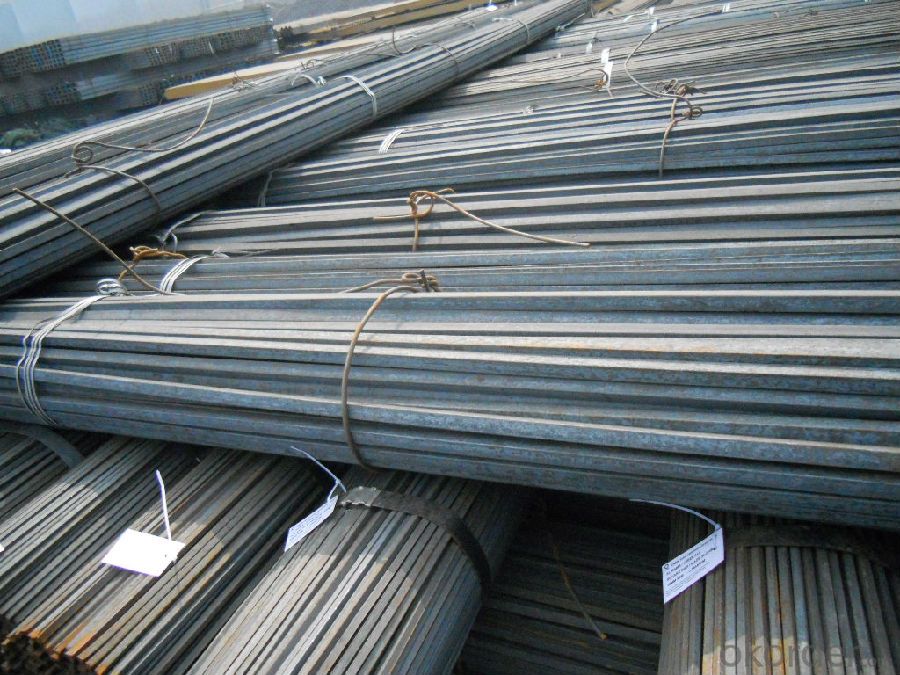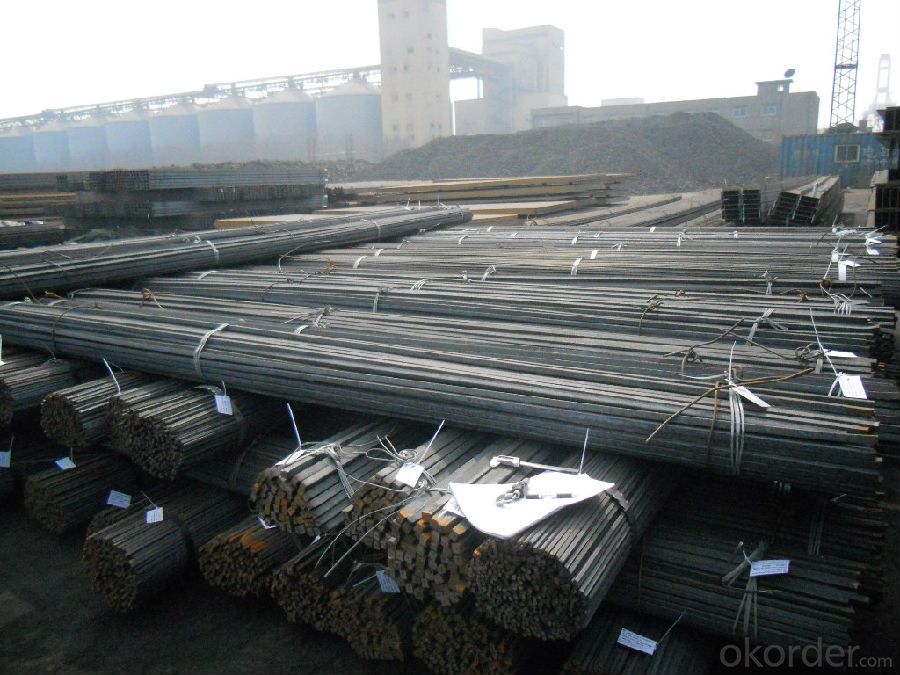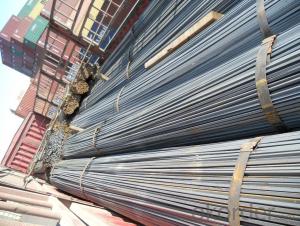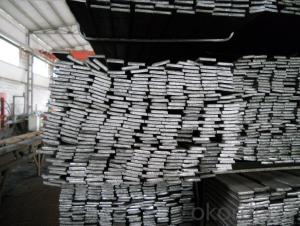Hot Rolled Structure Steel Square Bar with Many sizes
- Loading Port:
- Qingdao
- Payment Terms:
- TT or LC
- Min Order Qty:
- 25 m.t.
- Supply Capability:
- 3000 m.t./month
OKorder Service Pledge
OKorder Financial Service
You Might Also Like
Product Description:
OKorder is offering Hot Rolled Structure Steel Square Bar at great prices with worldwide shipping. Our supplier is a world-class manufacturer of steel, with our products utilized the world over. OKorder annually supplies products to European, North American and Asian markets. We provide quotations within 24 hours of receiving an inquiry and guarantee competitive prices.
Product Applications:
The Square Steel is normally used as structure steel.
Row material for other structure steel like steel angles, channels, I-beams, H-beams, etc…
Product Advantages:
OKorder's Hot Rolled Structure Steel Square Bar are durable, strong, and resist corrosion.
Main Product Features:
· Premium quality
· Prompt delivery & seaworthy packing (30 days after receiving deposit)
· Corrosion resistance
· Can be recycled and reused
· Mill test certification
· Professional Service
· Competitive pricing
Product Specifications:
Length of a side(mm) | Theoretical weight(kg/m) | Length of a side(mm) | Theoretical weight(kg/m) |
6 | 0.283 | 32 | 8.04 |
7 | 0.385 | 33 | 8.55 |
8 | 0.502 | 34 | 9.07 |
9 | 0.636 | 35 | 9.62 |
10 | 0.785 | 36 | 10.17 |
11 | 0.950 | 38 | 11.24 |
12 | 1.13 | 40 | 12.56 |
13 | 1.33 | 42 | 13.85 |
14 | 1.54 | 45 | 15.90 |
15 | 1.77 | 48 | 18.09 |
16 | 2.01 | 50 | 19.63 |
17 | 2.27 | 53 | 22.05 |
18 | 2.54 | 55 | 23.6 |
19 | 2.82 | 56 | 24.61 |
20 | 3.14 | 58 | 26.4 |
21 | 3.46 | 60 | 28.26 |
22 | 3.80 | 63 | 31.16 |
23 | 4.15 | 65 | 33.17 |
24 | 4.52 | 68 | 36.3 |
25 | 4.91 | 70 | 38.49 |
26 | 5.30 | 75 | 44.16 |
27 | 5.72 | 80 | 50.24 |
28 | 6.15 | 85 | 56.72 |
29 | 6.60 | 90 | 63.59 |
30 | 7.06 | 95 | 70.85 |
31 | 7.54 | 100 | 78.50 |
Notes:
1, The theoretical weights in the list, base on the density of 7.85 g/cm3.
2, The numbers with mean that they are not regulars or we don’t offer them.
-List 2. The allowed tolerance of Square Steel:
Length of a side(mm) | Allowed Tolerance | ||
Group1 | Group2 | Group3 | |
5.5~7 | ±0.20 | ±0.30 | ±0.40 |
7~20 | ±0.25 | ±0.35 | ±0.40 |
20~30 | ±0.30 | ±0.40 | ±0.50 |
30~50 | ±0.40 | ±0.50 | ±0.60 |
60~80 | ±0.60 | ±0.70 | ±0.80 |
80~110 | ±0.90 | ±1.0 | ±1.1 |
110~150 | ±1.2 | ±1.3 | ±1.1 |
150~190 | ―― | ―― | ±2.0 |
190~250 | ―― | ―― | ±2.5 |


Payment:
-Invoicing on theoretical weight or actual weight as customer’s request.
-Regular terms of payment:
1, 30% payment in advance, the remaining balance (70% payment) against the copy of B/L.
2, 30% payment in advance, the remaining balance (70% L/C) against the copy of B/L.
3, Negotiable.
FAQ:
Q1: Why buy Materials & Equipment from OKorder.com?
A1: All products offered byOKorder.com are carefully selected from China's most reliable manufacturing enterprises. Through its ISO certifications, OKorder.com adheres to the highest standards and a commitment to supply chain safety and customer satisfaction.
Q2: How do we guarantee the quality of our products?
A2: We have established an advanced quality management system which conducts strict quality tests at every step, from raw materials to the final product. At the same time, we provide extensive follow-up service assurances as required.
Q3: How soon can we receive the product after purchase?
A3: Within three days of placing an order, we will begin production. The specific shipping date is dependent upon international and government factors, but is typically 7 to 10 workdays.
Q4: What makes stainless steel stainless?
A4: Stainless steel must contain at least 10.5 % chromium. It is this element that reacts with the oxygen in the air to form a complex chrome-oxide surface layer that is invisible but strong enough to prevent further oxygen from "staining" (rusting) the surface. Higher levels of chromium and the addition of other alloying elements such as nickel and molybdenum enhance this surface layer and improve the corrosion resistance of the stainless material.
- Q:How do you use a steel square to determine the angle of a roof truss?
- To use a steel square to determine the angle of a roof truss, you would need to follow these steps: 1. Start by placing the steel square against the edge of the truss where the angle needs to be measured. Make sure the square is aligned properly and securely against the truss. 2. Take note of the scale on the steel square. This scale usually consists of numbers and lines that represent degrees. The most common steel square has scales for measuring 90 degrees, 45 degrees, and 30 degrees. 3. Locate the line on the scale that corresponds to the desired angle you are trying to measure. For example, if you want to determine the angle of a truss that is 30 degrees, find the line on the scale that reads 30 degrees. 4. Next, align the line on the steel square that corresponds to the desired angle with the edge of the truss. This line should be parallel to the truss edge. 5. Once the line on the steel square is aligned with the truss edge, check the other side of the square. There should be another line or edge that intersects with the truss. This intersecting point will give you the angle measurement. 6. Read the angle measurement directly from the scale on the steel square at the intersecting point. This will give you the exact angle of the roof truss. Remember to ensure that the steel square is properly aligned and securely positioned against the truss to get accurate measurements. Additionally, it is essential to use the correct scale on the steel square that matches the desired angle you are trying to determine.
- Q:What are the different sizes available for steel squares?
- There are various sizes of steel squares to accommodate different needs and applications. The most commonly found sizes are 6 inches, 12 inches, and 24 inches. These sizes indicate the length of the square's blade or the distance between the base and the blade. The 6-inch steel square is compact and perfect for small-scale projects or for those who prefer a more portable tool. It finds common use in tasks like marking, measuring, and checking right angles. The 12-inch steel square is a versatile choice that provides greater precision and accuracy. It is widely used in carpentry, woodworking, and metalworking projects that require more detailed measurements. This size is suitable for professionals as well as DIY enthusiasts. The 24-inch steel square is the largest available size and is typically utilized in construction, framing, and larger-scale projects. It features a longer blade that allows for measuring and marking over larger distances. This size is particularly suitable for professionals working on larger structures or projects that demand precise measurements and right angles. It is important to note that these sizes are standard, but manufacturers may offer variations and specialty sizes based on specific project requirements.
- Q:How do you use a steel square to determine the slope of a garden bed?
- To use a steel square to determine the slope of a garden bed, you can follow these steps: 1. Start by placing one edge of the steel square against the ground at the lowest point of the garden bed. 2. Ensure that the steel square is level by using a bubble level or by checking that the bubble is centered within the level. 3. Once the steel square is level, hold it steady in that position. 4. Look at the other edge of the square that is extending away from the ground. This edge represents the slope of the garden bed. 5. Observe the markings on the steel square. Most steel squares have measurements and angles marked on them. 6. Read the measurement or angle that corresponds to the line created by the edge of the square. This will give you the slope of the garden bed. 7. You can either note down the measurement or angle for future reference or use it to make necessary adjustments to the garden bed. By using a steel square, you can accurately determine the slope of a garden bed, which is crucial for proper drainage and irrigation.
- Q:How do you use a steel square to measure and mark 180-degree angles?
- To measure and mark 180-degree angles using a steel square, the following steps should be followed: 1. Position the steel square onto the surface or material where the angle needs to be measured. 2. Align one side of the square with a reference line or edge of the material. 3. Ensure that the right-angle corner of the square is placed at the starting point of the desired angle. 4. Rotate the square until the other side aligns with the intended direction of the angle. 5. Firmly hold the square in place once the desired angle is achieved. 6. Trace along the edge of the square using a pencil or marker to mark the 180-degree angle. 7. Remove the steel square, and the material will now bear a precise 180-degree angle marking. It is crucial to remember that a steel square is specifically designed for measuring and marking right angles (90 degrees). In order to measure and mark 180-degree angles, the right-angle corner of the square must be utilized and aligned accordingly to achieve the desired angle.
- Q:How do you use a steel square to find the height of a chimney?
- To use a steel square to find the height of a chimney, you will need a few basic tools and a clear understanding of the process. Here are the steps to follow: 1. Gather the necessary tools: You will need a steel square, a measuring tape or ruler, a level, and a ladder or other means to access the chimney. 2. Position yourself at a distance from the chimney where you can clearly see its top edge. Ensure you have a clear line of sight. 3. Hold the steel square in your hand, with one arm of the square pointing upwards and the other arm pointing horizontally. 4. Extend your arm with the horizontal arm of the square until it aligns with the bottom edge of the chimney. Be careful to keep the square level and parallel with the ground. 5. While maintaining the square in position, adjust your position until the top edge of the chimney aligns with the vertical arm of the steel square. 6. Once the chimney's top edge aligns with the vertical arm of the square, take note of the distance between your hand and the bottom edge of the chimney. This distance represents the height of the chimney. 7. Use a measuring tape or ruler to measure the distance between your hand and the bottom edge of the chimney. Make sure to hold the tape or ruler straight and parallel to the ground for accurate measurement. 8. Once you have the measurement, it represents the height of the chimney from your specific vantage point. It's important to note that this method provides an estimate of the chimney's height, assuming the ground is level and your line of sight is accurate. If you require a more precise measurement, it may be necessary to use alternative methods or consult a professional.
- Q:Can a steel square be used for stair-building projects?
- Certainly! A steel square is capable of being utilized in stair-building endeavors. Commonly known as a framing square or carpenter's square, this versatile tool is frequently employed in woodworking and construction undertakings. With its 90-degree angle, it is ideal for measuring and delineating right angles, a crucial element in stair construction. By means of a steel square, one can assess the precision of cuts and angles, guarantee the proper positioning of stringers and treads, and confirm the levelness and stability of the stair framework. This enduring and dependable instrument is applicable for both residential and commercial stair-building ventures.
- Q:What are some common conversions and calculations that can be done with a steel square?
- A steel square, also known as a framing square or carpenter's square, is a versatile tool used in carpentry and woodworking. It consists of a long blade and a shorter tongue that meet at a right angle. Here are some common conversions and calculations that can be done with a steel square: 1. Measuring and marking: The steel square can be used to measure and mark straight lines or right angles on a piece of wood or other materials. It is particularly useful in determining 90-degree angles for accurate cuts and joint construction. 2. Determining squareness: By using the square's 90-degree angle, you can check the squareness of corners and ensure they are perfectly perpendicular. This is important for constructing frames, cabinets, and other structures. 3. Finding roof pitch: Carpenters often use a steel square to determine the pitch or slope of a roof. By placing the square on the roof surface and aligning it with the rafters, the angle of the roof pitch can be measured. 4. Calculating rafter lengths: A steel square can also be used to calculate the length of rafters for roofs. By using the square's markings and angles, carpenters can quickly determine the appropriate length of rafters needed for a specific roof design. 5. Making angle cuts: The steel square can be used to mark and guide angle cuts on wood or other materials. By aligning the square's blade or tongue with the desired angle and marking the cut line, precise angle cuts can be achieved. 6. Creating parallel lines: The square's straight edge can be used to draw parallel lines by simply sliding it along the edge of the material while keeping it aligned with the desired distance. 7. Measuring and transferring dimensions: The square can be used as a ruler or measuring device for both straight and diagonal measurements. It is useful in transferring measurements from one piece of material to another accurately. 8. Checking flatness: The steel square can also be used to check the flatness of a surface. By placing it on a flat surface and observing if the entire length is in contact, any deviations or unevenness can be detected. Overall, a steel square is a versatile tool that can be used for a wide range of conversions and calculations in carpentry and woodworking. Its ability to measure, mark, determine angles, and assist in various construction tasks makes it an essential tool for any carpenter or woodworker.
- Q:How do you use a steel square to mark out 75-degree angles?
- To mark out 75-degree angles using a steel square, the following steps are typically followed: 1. Ensure that the long side of the square is parallel to the edge where the angle will be marked, and place it on a flat surface or workpiece. 2. Align one edge of the square with the desired starting point of the angle, which will serve as the reference line for marking. 3. Locate the line on the steel square that represents a 45-degree angle, usually marked with a number or symbol. 4. Starting from the reference line, count inwards along the 45-degree angle line in the direction of the desired angle. In this case, measure 30 degrees inward along the 45-degree line. 5. Once the appropriate distance is measured, make a mark at that point, indicating the starting point of the 75-degree angle. 6. From the starting point, measure an additional 75 degrees in the desired direction, using the appropriate scale on the steel square. This can be the 90-degree line or a specific angle scale marked on the square. 7. Make a second mark at the endpoint of the 75-degree angle, completing the marking process. Remember to verify your measurements and use a sharp pencil or marker for accurate and visible markings. It is also advisable to practice using the steel square on scrap material before marking the final workpiece to ensure precision.
- Q:How do you use a steel square for checking corner squareness?
- To use a steel square for checking corner squareness, simply place the square against the corner, ensuring that both legs of the square touch the adjacent walls. If the corner is square, the edges of the square should align perfectly with the walls. If there is any gap or overlap, it indicates that the corner is not square.
- Q:How do you use a steel square to lay out a pentagon?
- To use a steel square to lay out a pentagon, start by marking a straight line on the material. Then, position the steel square on the line with one leg aligned with the edge. Use the other leg to mark the desired length of one side of the pentagon, making a perpendicular line from the first line. Repeat this step four more times, connecting the marks to form the pentagon's shape.
1. Manufacturer Overview |
|
|---|---|
| Location | |
| Year Established | |
| Annual Output Value | |
| Main Markets | |
| Company Certifications | |
2. Manufacturer Certificates |
|
|---|---|
| a) Certification Name | |
| Range | |
| Reference | |
| Validity Period | |
3. Manufacturer Capability |
|
|---|---|
| a)Trade Capacity | |
| Nearest Port | |
| Export Percentage | |
| No.of Employees in Trade Department | |
| Language Spoken: | |
| b)Factory Information | |
| Factory Size: | |
| No. of Production Lines | |
| Contract Manufacturing | |
| Product Price Range | |
Send your message to us
Hot Rolled Structure Steel Square Bar with Many sizes
- Loading Port:
- Qingdao
- Payment Terms:
- TT or LC
- Min Order Qty:
- 25 m.t.
- Supply Capability:
- 3000 m.t./month
OKorder Service Pledge
OKorder Financial Service
Similar products
New products
Hot products
Hot Searches
Related keywords




























